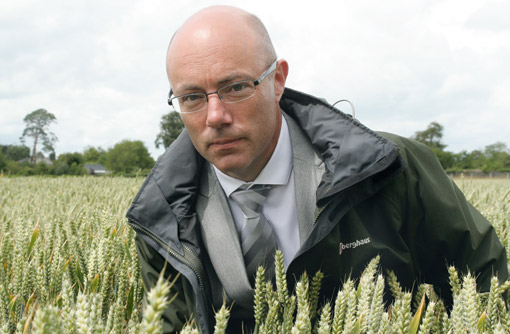Experts debate the causes of the lower wheat yields in 2012

What went wrong with wheat yields in 2012? Louise Impey takes a look at the findings from the UK and Ireland and at a BASF-organised briefing asks how growers can avoid a repeat performance in the coming year
Whether you were farming in England, Scotland or Ireland in 2012, there were some common reasons for the disappointing wheat yields seen at harvest, agree the experts.
Familiar to all regions were heavy rainfall, low light levels, high disease pressure and difficult spraying conditions, all of which had a part to play in reducing wheat yields by between 15% and 30%.
Add in a high incidence of both barley yellow dwarf virus (BYDV) and take-all, poor spray timing, waterlogging, ear disease at levels previously unseen and insufficient radiation during the grain filling period, and you start to get some sort of an explanation for harvest 2012.
Scotland
Unlike other areas, there was never any mention of a drought in Scotland, says Fiona Burnett of Scotland’s Rural College (SRUC).
“Soils have been at saturation for 18 months,” she says. “We had a wet autumn in 2011, followed by a warm winter with plenty of rainfall, and it has remained that way ever since.”
Once into the 2012 growing season, a warm March, followed by a cold April, made spray timings more difficult than usual. “Crops stalled in April, giving a prolonged period around the T1 timing and a long gap until T2. Not surprisingly, spray timings went wrong.”
After that, solar radiation in July, when it’s most needed for wheat, was just 60% of the norm, she continues. “We ended up with an average winter wheat yield of 6.79t/ha, which was 16% below the 2011 level. Winter barley was more tolerant of the wet and oats did relatively well.”
Commercially, growers were disappointed with fungicide performance, acknowledges Dr Burnett. “But if there’s one lesson learnt, it is that fungicides are all about using enough. There was a strong dose response in 2012, even where yields were down.”
The earlier sprays proved to be the most important, she reveals. “Crops threw in the towel in July and there was very little response to late sprays.”
So, although disease levels were significant, they were almost the least of the crop’s problems, she believes. “Fungicide rates and timings had to be right. But yields were limited by early senescence, crop stress and lack of sunlight.”
There wasn’t a single variety/fungicide programme which gave the right solution in 2012, she says. “Localised showers had a big impact, as did flowering spray timings. Microdochium was a big issue in some crops and we did have some sterility issues in certain varieties.”
Ireland
Ireland’s 2012 was miserable, sums up John Spink of Teagasc.
Winter wheat yields were down by 29% on the previous year, with seemingly “good” crops performing worse than thin crops, he says.
Both BYDV and take-all took hold in a very warm, wet winter, with some plants dying in January from continuous infection.
Crops going into spring were advanced, he says. “That meant that T1 sprays were made too early and there was a huge gap until T2. The fact that summer rainfall was almost double that of 2011 gave us further problems with spraying.”

John Spink, Teagasc
Poor grain filling conditions followed. The process started 10 days later than in 2011 and was shorter by between two and six days, depending on location, recalls Mr Spink. “There was a 13-22% reduction on radiation during grain fill, with the effects being worse further south.”
Waterlogging was responsible for the disastrous crops on heavy, poorly structured ground, he says. “And then fusarium came in. Yield losses from this alone came to 1.5t/ha.”
Fungicide performance showed some changes in 2012, reports Mr Spink. “Shifts in the septoria population mean that the triazoles slipped, with metconazole doing a better job than either prothioconazole or epoxiconazole.”
Triazole mixes did far better than straight triazoles. “And the SDHIs worked well. It was worth spending money on the timings which offer the best control.”
In summary, he blames high rainfall, dull grain filling conditions and ear blight for the poor yields. “There’s no hiding from the fact that traditional timings and good spray timeliness are key to good disease control.”
England
The farmer’s nightmare. That’s how Bill Clark, commercial technical director at NIAB TAG, describes 2012.
 “Spring was warm and dry and there was talk in the national media of drought,” he says. “But the wet weather that then followed gave us some of the worst septoria ever seen.”
“Spring was warm and dry and there was talk in the national media of drought,” he says. “But the wet weather that then followed gave us some of the worst septoria ever seen.”
Just like the rest of the country, forward wheat crops were slowed by a cold April and spray timings were extended. “It meant that leaf 2 was infected early and the flag leaf spray was too late. The drop in temperature slowed leaf emergence more than it slowed septoria.”
That gave fungicides a difficult job to do, believes Mr Clark. “Even the best products can only give 50-60% control in an eradicant situation. And remember, the T0 and T1 treatments were driven by fears of yellow rust, not septoria, so product choice was compromised.”
Added to that, sunshine levels were too low. “Solar radiation was down by 20% in June. That gave us a warning that yields would be affected.”
The effects of waterlogging are less well known, he continues. “But there is work from other parts of the world which shows that it interferes with photosynthesis and prevents the redistribution of stem carbohydrates. And when it occurs at flowering, it can be very damaging to yields.”
That could help explain why crops on lighter land did better than those on heavy soils. And late drillings also seemed to escape the worst.
Fusarium ear blight, which isn’t usually significant in terms of yield, also did some damage. “But it was impossible to control. There was high incidence and severity of the disease,” says Mr Clark.
Regional variation, which also existed, is being examined by a NIAB TAG-led task force, he says. “We know that soil type was significant and there were some varietal effects too. We hope to have more to say from that by the end of the year.”
| What about 2013? |
|---|
Disease carry over to next year will be significant, warns SRUC’s Dr Fiona Burnett. “That should increase the emphasis on preventative control and resistant varieties,” she says. “No amount of chemistry helped on the weaker varieties this year.” A greater use of T0s and putting SDHIs on at T1 are her top tips for improving on the last year. “Things got away in 2012. That must not happen again.” Teagasc’s John Spink believes there’s no need to spend a lot of money at T0. “A litre of chlorothalonil will suffice.” SDHIs should feature at T1 and T2, he says. “Always include a multi-site protectant with them and have a triazole co-formulation in the T1 spray.” His other tip is to monitor leaf emergence. “The biggest thing that growers can do to help is make sure they put the fungicide on at the right time.” NIAB TAG’s Bill Clark’s advice is clear. “Put higher doses on. Don’t cut rates, even in a low disease year. The response to fungicides was still very good in 2012.” |
Keep up with the latest arable news

